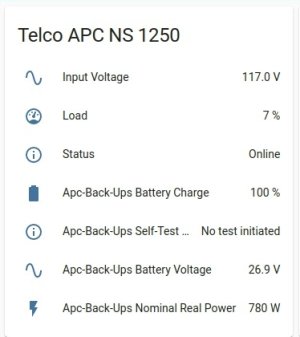I'm considering ways to have the components of a security/HA panel (M1G, M1XEP, maybe a LAN switch, maybe a Hubitat, etc.) plug into a typical UPS. The benefits would be additional battery backup time, surge protection, etc. The UPS's are too big to put inside the panel, so here's how I'm thinking about having it outside the panel. Note that the panel (Elk SWB28) will be in a bedroom closet, recessed into the wall. The wall has 2x6 studs, so there's plenty of depth in the wall.
The panel will have an outlet with a double receptacle in the bottom. Instead of outlet being powered directly from a circuit, the romex wire will go to a male outlet receptacle like this...
MIDLITE 4642-W Single Gang Décor Recessed Power Inlet
...that will be located a few feet away next to a regular 120v outlet receptacle. The UPS will plug into the live receptacle, and a short extension cord will be plugged in between the UPS outlet and the male receptacle, and that will power the outlet in the panel. The M1G gets plugged into one of the receptacles in the panel. A power strip gets plugged into the other receptacle to allow for multiple transformers, etc. The results are...
1. Additional battery backup and surge suppression for the M1G.
2. A place to plug in multiple devices (with or without transformers) and give them battery backup and surge suppression.
Anyone know if the above will meet code? Any comments, positive or negative, or other solutions? I have a Tripp Lite AV550SC UPS that is made to go inside a panel, but it takes up a lot of space.
Ira
The panel will have an outlet with a double receptacle in the bottom. Instead of outlet being powered directly from a circuit, the romex wire will go to a male outlet receptacle like this...
MIDLITE 4642-W Single Gang Décor Recessed Power Inlet
...that will be located a few feet away next to a regular 120v outlet receptacle. The UPS will plug into the live receptacle, and a short extension cord will be plugged in between the UPS outlet and the male receptacle, and that will power the outlet in the panel. The M1G gets plugged into one of the receptacles in the panel. A power strip gets plugged into the other receptacle to allow for multiple transformers, etc. The results are...
1. Additional battery backup and surge suppression for the M1G.
2. A place to plug in multiple devices (with or without transformers) and give them battery backup and surge suppression.
Anyone know if the above will meet code? Any comments, positive or negative, or other solutions? I have a Tripp Lite AV550SC UPS that is made to go inside a panel, but it takes up a lot of space.
Ira

